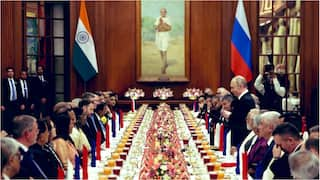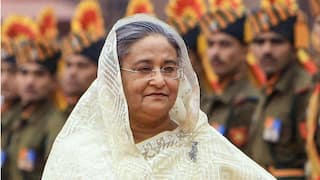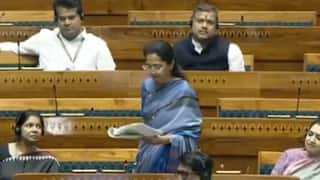RBI MPC Meeting: Unchanged Repo Rate, Inflation Projection, Gold Loans Limit, OMO Sales — Key Takeaways
The RBI MPC decided by a majority of 5 out of 6 members to remain focused on "withdrawal of accommodation" to ensure that inflation progressively aligns to the target, while supporting growth

The Reserve Bank of India (RBI) monetary policy committee (MPC) decided to leave the key lending repo rate unchanged at 6.5 per cent for the fourth consecutive time while remaining "highly alert and prepared to undertake timely policy measures," to align inflation to the target." Similarly, the central bank led by Governor Shaktikanta Das on Friday retained the inflation forecast for 2023-24 at 5.4 per cent.
Governor Shaktikant Das in his statement said, "Headline inflation had surged in July driven by tomato and other vegetable prices. It corrected partly in August and is expected to see further easing in September on the back of moderation in these prices."
"The overall inflation outlook, however, is clouded by uncertainties from the fall in kharif sowing for key crops like pulses and oilseeds, low reservoir levels, and volatile global food and energy prices. The MPC observed that the recurring incidence of large and overlapping food price shocks can impart generalisation and persistence to headline inflation...The transmission of the 250 basis points (bps) increase in the policy repo rate to bank lending and deposit rates is still incomplete and hence the MPC decided to remain focused on withdrawal of accommodation."
Also Read: RBI MPC Meeting: PM Vishwakarma Included Under PIDF Scheme, Tenure Extended By Two More Years
Here are the key takeaways from the RBI's October monetary policy decision
- The Monetary Policy Committee (MPC) after a detailed assessment of the evolving macroeconomic and financial developments decided unanimously to keep the policy repo rate unchanged at 6.50 per cent.
- The standing deposit facility (SDF) rate remains at 6.25 per cent and the marginal standing facility (MSF) rate and the Bank Rate at 6.75 per cent.
- The MPC also decided by a majority of 5 out of 6 members to remain focused on "withdrawal of accommodation" to ensure that inflation progressively aligns to the target, while supporting growth.
- The interest rates status quo means retail, as well as corporate borrowers, will have a stable borrowing rate. Following the Russia-Ukraine war, the central bank began gradually raising the policy rate starting in May 2022, and it was raised to 6.5 per cent in February of this year. Since then, it has maintained the rate throughout its bi-monthly reviews of monetary policy.
- The RBI's expected CPI-based inflation rate for the ongoing financial year remains at 5.4 per cent, while the MPC will continue to monitor inflation and is steadfast in its resolve to bring it into line with the desired level.
- The retail inflation projection was kept at 5.4 per cent for FY24. The prediction for the second quarter of FY24 has been increased from 6.2 to 6.4 per cent. The inflation forecast for Q3FY24 has been reduced from 5.7 per cent to 5.6 per cent. The estimate has remained at 5.2 per cent for Q4FY24. The inflation forecast for Q1FY25 has remained at 5.2 per cent.
- As per RBI, in contrast to global trends, domestic economic activity exhibits resilience on the back of strong domestic demand. Investment activity maintained its momentum with good support from government capex.
- The RBI projected real GDP growth for 2023-24 at 6.5 per cent with Q2 at 6.5 per cent; Q3 at 6.0 per cent; and Q4 at 5.7 per cent. Real GDP growth for Q1FY25 is projected at 6.6 per cent.
- RBI Governor said India’s merchandise exports and imports have remained in the contractionary zone so far during 2023-24, although at a decelerated pace during July and August. Services exports grew at a healthy pace in Q1FY24 and remained strong during July and August 2023 driven by software and business services.
- As per the central bank inward remittances have risen by 5.8 per cent year on year, and the current account deficit (CAD) for Q1FY24 declined to 1.1 per cent of GDP from a year ago.
- The foreign portfolio investment (FPI) flows have seen a significant turnaround in 2023-24 with net FPI inflows at $ 20.3 billion up to September 2023 as against net outflows in the preceding two years.
- Net foreign direct investment (FDI), on the other hand, moderated to $ 5.8 billion in April-July 2023 from $ 17.3 billion a year ago.
- To ensure that liquidity conditions are in sync with the monetary policy stance, the Reserve Bank had imposed an incremental cash reserve ratio (I-CRR) of 10 per cent. The I-CRR was reviewed and it is being discontinued in a phased manner, ending October 7, 2023, Governor Shaktikanta Das said.
- Going forward, while remaining nimble, RBI will have to consider OMO sales (Open Market Operation sales) to manage liquidity, consistent with the stance of monetary policy. The timing and quantum of such operations will depend on the evolving liquidity conditions, Das said.
- Among certain additional measures, the RBI said, with a view to harmonise the credit concentration norms among NBFCs, it has been decided to permit NBFCs in the Middle and Base Layers to use Credit Risk Mitigation (CRM) instruments for reducing their counterparty exposure under the credit concentration norms.
- RBI has decided to increase the existing limit for Gold Loans under the Bullet Repayment scheme from Rs 2 lakh to Rs 4 lakh in respect of Urban Co-operative Banks (UCBs) who have met the overall target and sub-targets under the Priority Sector Lending (PSL) as on March 31, 2023.
- It has been decided to issue a draft omnibus framework for recognising Self-Regulatory Organisations (SROs) for various categories of Regulated Entities (REs) of the Reserve Bank for stakeholder comments. Additional sector-specific conditions may also be prescribed at the time of calling for applications.
- The Payments Infrastructure Development Fund (PIDF) scheme has been extended by two years, that is, up to December 31, 2025. The coverage of the PIDF scheme is also being expanded to include the beneficiaries of the PM Vishwakarma Scheme.
- The central bank introduced New Channels for Card-on-File Tokenisation (CoFT) facilities directly at the issuer bank level. This measure will enhance convenience for cardholders to get tokens created and linked to their existing accounts with various e-commerce applications.






































